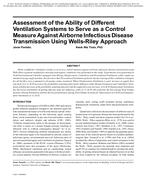Description
Ability of different ventilation systems to serve as a control measure against airborne infectious disease transmission using Wells-Riley equation modified for unsteady heterogenic conditions was performed in this study. Experiments were performed in Field Environmental Chamber equipped with Mixing, Displacement, Underfloor and Personalized Ventilation, while cough was simulated using cough machine. Results show that Personalized Ventilation performs the best among all the ventilation strategies for all the flow rates examined at all quanta values examined. When Displacement Ventilation is used, increase in supply flow rate form 6 to 12 ACH increases the probability of getting infected for Influenza while Mixing Ventilation and Underfloor Ventilation exhibits decrease of the probability of getting infected with the supply flow rate increase. At 6 ACH Displacement Ventilation has the lowest probability of getting infected value for Influenza, while at 12 ACH, MV performs the best among Total Volume Systems. Mixing Ventilation exhibits the best performance among Total Volume Systems for Tuberculosis at 6 ACH and Displacement Ventilation at 12 ACH.
Citation: IAQ Conference: IAQ 2010: Airborne Infection Control
Product Details
- Published:
- 2011
- Number of Pages:
- 6
- File Size:
- 1 file , 530 KB
- Product Code(s):
- D-IAQ2010-C157-10




